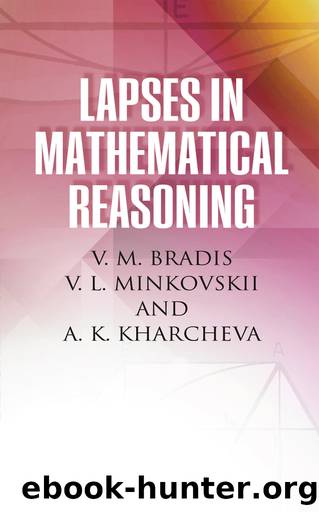Lapses in Mathematical Reasoning by V. M. Bradis

Author:V. M. Bradis [V. M. Bradis, V. L. Minkovskii and A. K. Kharcheva]
Language: eng
Format: epub
Publisher: Dover Publications
Published: 2016-11-14T16:00:00+00:00
and namely
is equal to one of the values of the square root of the number zzâ², namely to the number:
Now the question arises whether this latter number is the âfirstâ value of the root of zzâ², or whether this âfirstâ value is the second value of the root of zzâ², designated by us by the letter Ï .
From the conditions and , we conclude that and . In other words, the point representing the number u may lie either on the positive portion of the x-axis or above the x-axis , or on the negative portion of the x-axis , or below the x-axis . Thus the product of the âfirstâ values of the roots of z and zâ² may be equal in some cases to the âfirstâ value of the root of zzâ², and in other cases to its âsecondâ value.
By considering instead of the values of half the sum of the arguments , the value of the whole sum α + αâ², and collecting in pairs the four cases considered above, we arrive at the following two cases:
Case I. If α + αⲠ< 360°, then either , or ; the number u is represented either by a point of the positive portion of the x-axis, or by a point of the upper half-plane; u is equal to the âfirstâ value of the root of zzâ².
Case II. If α + αⲠ> 360°, then either , or , the number u is represented either by a point of the negative portion of the x-axis, or by a point of the lower half-plane; u is equal to the âsecondâ value of the root of zzâ².
We now obtain the final conclusion: the product of the âfirstâ values of square roots of complex numbers z and zâ² is equal to the âfirstâ value of the square root of the product of these numbers if, and only if, the sum of the arguments of these numbers is less than 360° (it is assumed that the arguments are selected within the limits 0â360°).
Noting that the âsecondâ value of the square root is equal to its âfirstâ value, taken with the opposite sign, we can, by making use of the last proposition, easily construct the following âtable of multiplicationâ for square roots of complex numbers (the âfirstâ values of the square root we shall denote by the plus sign in front of the square root symbol, and the âsecondâ value by the minus sign). Just as before, we assume that the arguments α and αⲠof the numbers z and zâ² are taken between 0° and 360°.
Download
This site does not store any files on its server. We only index and link to content provided by other sites. Please contact the content providers to delete copyright contents if any and email us, we'll remove relevant links or contents immediately.
| Applied | Geometry & Topology |
| History | Infinity |
| Mathematical Analysis | Matrices |
| Number Systems | Popular & Elementary |
| Pure Mathematics | Reference |
| Research | Study & Teaching |
| Transformations | Trigonometry |
Modelling of Convective Heat and Mass Transfer in Rotating Flows by Igor V. Shevchuk(6408)
Weapons of Math Destruction by Cathy O'Neil(6221)
Factfulness: Ten Reasons We're Wrong About the World – and Why Things Are Better Than You Think by Hans Rosling(4716)
A Mind For Numbers: How to Excel at Math and Science (Even If You Flunked Algebra) by Barbara Oakley(3262)
Descartes' Error by Antonio Damasio(3250)
Factfulness_Ten Reasons We're Wrong About the World_and Why Things Are Better Than You Think by Hans Rosling(3218)
TCP IP by Todd Lammle(3158)
Fooled by Randomness: The Hidden Role of Chance in Life and in the Markets by Nassim Nicholas Taleb(3083)
Applied Predictive Modeling by Max Kuhn & Kjell Johnson(3043)
The Tyranny of Metrics by Jerry Z. Muller(3032)
The Book of Numbers by Peter Bentley(2935)
The Great Unknown by Marcus du Sautoy(2666)
Once Upon an Algorithm by Martin Erwig(2625)
Easy Algebra Step-by-Step by Sandra Luna McCune(2607)
Lady Luck by Kristen Ashley(2556)
Police Exams Prep 2018-2019 by Kaplan Test Prep(2518)
Practical Guide To Principal Component Methods in R (Multivariate Analysis Book 2) by Alboukadel Kassambara(2516)
All Things Reconsidered by Bill Thompson III(2374)
Linear Time-Invariant Systems, Behaviors and Modules by Ulrich Oberst & Martin Scheicher & Ingrid Scheicher(2348)
